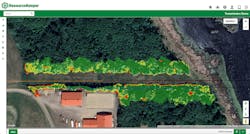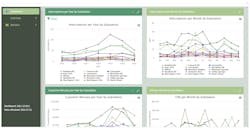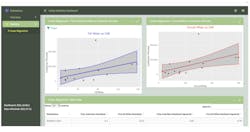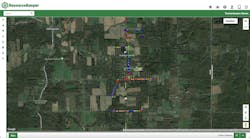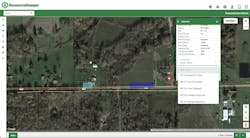Improving Storm Response: The Role of SaaS Solutions for Utilities
For utilities, reliability is everything. So, when there's a storm event causing an outage, every second counts. What’s needed is rapid, responsive storm and disaster recovery.
Yet, for many utilities, it can be challenging and even chaotic to allocate resources and effectively manage emergency response. This is especially true when storm response management spans multiple departments and operation centers.
Why Utilities Need Better Visibility and Operational Clarity
Despite sophisticated situational awareness and storm-tracking tools, the crucial tasks of assigning, tracking and pivoting in-the-field assignments often lie outside the realm of these tools. Often, storm response management is a maze of disparate software applications, online spreadsheets, text and phone messages and manual processes.
The lack of an integrated tracking system can make managing storm response feel like navigating a hurricane with only a handheld compass. Even worse, this methodology can slow down response time when it matters most.
Without full visibility into what’s happening, where, and with whom, utilities risk becoming like their outage customers —operating in the dark. So, when it comes to storm response, visibility is key to smarter decision-making.
Fortunately for a major utility operating in the south-central region of the United States, they found the missing piece to their emergency preparedness puzzle: an enterprise-wide Software as a Service (SaaS) solution.
The Storm Response Challenge: Integrated, Real-Time Tracking
The stakes are high when it comes to storm response. In addition to the physical ramifications of a storm, utilities also are working to keep customers satisfied, concerned about complying with state and federal regulations and dealing with safety concerns for property, personnel and the public.
This utility, located in one of the highest storm regions of the country, was looking for operational clarity, workflow automation and decision-support tools. Specifically, they wanted to trade their traditional response efforts for well-orchestrated restoration campaigns — all without the need to cobble together spreadsheets, documents and various and sundry computer-based programs.
So, they turned to one of their existing partners, the Davey Resource Group (DRG), for help.
“The utility’s tree crews had been using our SaaS platform, ResourceKeeper, for routine maintenance for many years,” said DRG Manager of Technology Justin Walters. “But the biggest gap — through no fault of their own — was with outages. They're located in a very high storm area, so it’s a constant battle to improve storm response.”
Until recently, the utility was relying on a complicated system involving a CADS, or computer-aided dispatching service, along with a nonintegrated separate software solution for field personnel. It was a highly labor-intensive and less-than-effective process.
“Their process involved driving the circuit, locating the outage, plotting it in one software, sending it back to GIS, then updating it in CADS, and so on,” says Walters. “They’re a long-standing partner for utility vegetation management, so they were already using ResourceKeeper for veg management but not for storm response. Instead, their struggle was with an in-house built and supported collection software. These separate processes and software platforms were slowing their storm response down because they couldn’t do all the workflows they needed to through it. So, we talked about a single-source solution, a hub, if you will, that could lead to better efficiency. The rest, as they say, is history.”
A SaaS Solution for Storm Work
Walters and others on the DRG team introduced the utility to ResourceKeeper’s storm work capabilities within its paperless suite of tools.
“Every utility has a protocol about what they deploy when there’s a storm event,” said Darik Warnke, manager of sales and narketing for DRG Utility Vegetation Management (UVM). “They use various software solutions to pull the information they’re collecting, whether that means downed lines, uprooted trees about to fall on the lines, live lines on the ground and the like. With ResourceKeeper, utilities can track, manage, assign and locate all the events and the issues they need to address from a storm perspective. It’s a technology-based solution with a mobile app designed for real-time data collection. For utilities, it can help support operations, guide management decisions and protect their investments. Plus, it can be scaled to any utility’s unique organizational structure and specifications.”
Here's how it works: The utility quickly and easily sends information through ResourceKeeper, dispatching storm work to tree crews, foresters or whoever needs it. Field personnel complete their tasks using the mobile app. Then the software automatically sends that information back to the outage management system (OMS) where it’s marked as complete before continuing through the rest of the utility’s workflow.
Because it integrates with their OMS, the SaaS solution not only supports customer ticket and outage investigations and response, but it also gives the utility advanced reporting capabilities and an even bigger benefit, analytics.
"Being able to look at peaks and valleys, minutes interrupted, how much work is accomplished by bucket crews versus manual crews, there's a lot you can extrapolate from the data," Walters said. "The analytics can also help decision-makers see trends over time, year-over-year, chart the leading causes of outages and document reliability metrics for regulatory compliance. Of course, we're continually adding in data science behind the scenes, building out new correlations to further enhance the usefulness of the data."
Implemented in 2024, the results have already exceeded the utility’s expectations. So far, they’ve lowered restoration times, optimized resource deployment and achieved a level of operational intelligence that has transformed their data into a more powerful storm response tool.
Is Technology the Answer to Improving Storm Response?
It’s no secret that utilities are continually on the lookout for ways to improve reliability in the face of increasingly more (and more severe) weather events. Fortunately, advanced technologies, such as SaaS platforms, are making a profound difference in how utilities can prepare for, respond to, and mitigate storm-related disruptions.
“A SaaS platform that transforms disparate workflows into a coordinated response has the potential to empower utilities now and for the long term," Walters said. "The key is to implement advanced technologies that can be integrated with legacy systems so the utility can take a more proactive approach to storm response. Ultimately, utilities will want a solution that helps them minimize downtime, optimize resource allocation and ensure critical infrastructure resilience.”
7 Questions to Consider When Choosing a Storm Response Platform
For utilities looking for their own SaaS solution for storm response, Walters recommends looking for a solution that can deliver cost savings, time efficiencies and eliminate cross-platform confusion.
Since not all SaaS platforms are created equal, here are seven questions to ask a potential partner about their storm response solution.
1. Can it streamline operations?
Every utility has its own workflow and since the key to rapid storm response is workflow efficiency, find out if the solution enables personnel to spend their time focusing on tasks rather than managing disparate platforms or chasing information.
2. Does it enhance communication and collaboration?
“Being on the same page” is a given in any high-stakes situation, such as a storm outage. Having a shared understanding of the situation is essential since breakdowns in communication can create confusion and slow down response time. Make sure the solution not only fosters clear communication but that it also promotes cross-functional collaboration.
3. Does it feature centralized data management?
By consolidating various data sources into a single platform, utilities can better track and manage vegetation-related issues after a storm event. A centralized hub can make a big difference in how much time, effort, and personnel it takes to assess a situation, decide and respond.
4. Can it improve response time?
Minimizing the impact of a storm event on service delivery is always a top priority, so nothing means more than visibility and tracking of storm-related issues. The best SaaS solutions should demonstrate how they can help speed response to outages and safety concerns.
5. Does it offer data-informed insights for real-time decision-making?
Accessibility and accuracy are critical components when choosing a technology-based storm response solution. Utilities should look for a SaaS platform that gives them easy access to real-time information and insights so they can be more strategic and proactive in their storm response.
6. Does it support compliance?
As utilities know, unintentional mismanagement of regulatory requirements can be a very expensive mistake. When comparing solutions, be sure to look for one that delivers data-informed insights so decision-makers can prioritize storm recovery work and avoid potential fines associated with non-compliance.
7. Can it support long-term planning?
For utilities, immediate response to a storm event is only part of the crisis response equation. Continuous improvement tactics include looking at the root cause, conducting incident post-mortems and developing mitigation and prevention strategies. Inquire whether the SaaS solution can leverage historical data to boost reliability metrics, help utilities better prepare for future events, and minimize the likelihood of outages.
About the Author
Jill Rebuck
Jill Rebuck ([email protected]) is a senior project manager in corporate communications for The Davey Tree Expert Company, an employee-owned corporation that provides research-driven tree services, grounds maintenance and environmental and utility infrastructure consulting for residential, utility, commercial and environmental partners in the United States and Canada. Rebuck is a graduate of Kent State University in Kent, Ohio, and holds a bachelor’s degree in public relations. She resides in Akron, Ohio.
